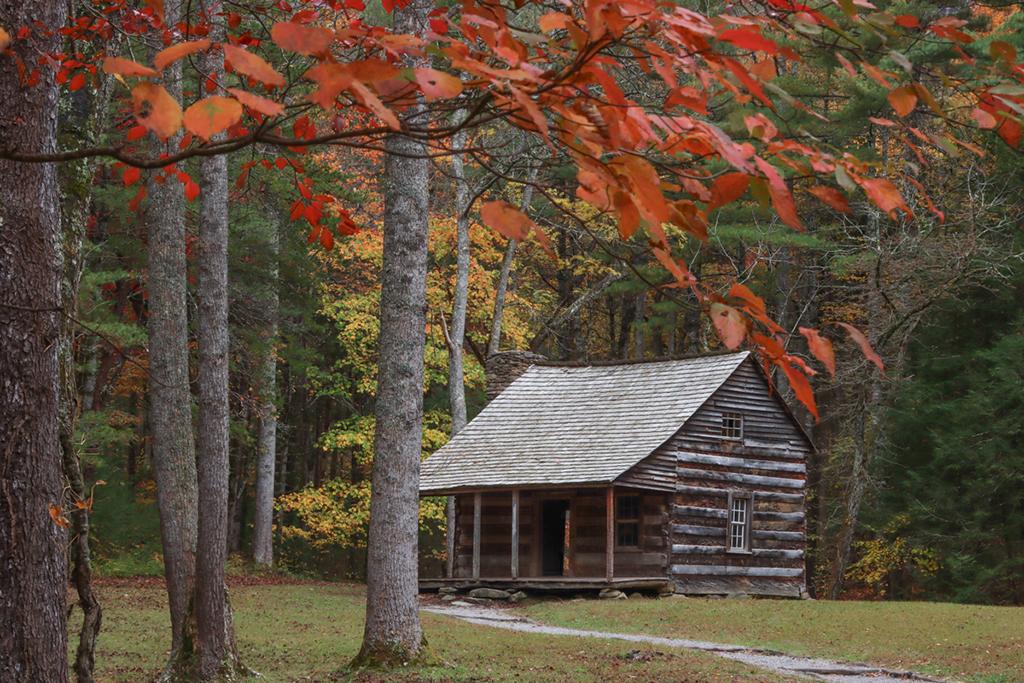The mountains that hold up the park have a long human history, one spanning thousands of years—from the prehistoric Paleo Indians to early European settlement in the 1800s to loggers and Civilian Conservation Corps enrollees in the 20th century.

Carter Shields cabin, Great Smoky Mountains National Park / NPS - Warren Bielenberg
This human history is just as rich as the park's natural history, with just as many stories to tell.
When the first white settlers reached the Smokies in the late 1700s, they found themselves in the land of the Cherokee Indians. The tribe, one of the most culturally advanced on the continent, had permanent towns, cultivated croplands, sophisticated political systems, and extensive networks of trails. Most of the Cherokee, however, were forcibly removed in the 1830s to Oklahoma in a tragic episode known as the "Trail of Tears." The few who remained are the ancestors of the Cherokees living near the park today.
Life for the early European settlers was primitive, but by the 1900s there was little difference between the mountain people and their contemporaries living in rural areas beyond the mountains.

1926 image of a stump of a large tulip poplar tree cut by Little River Lumber Company, Great Smoky Mountains National Park / NPS - Jim Shelton
Earlier settlers lived off the land by hunting the wildlife, utilizing the timber for buildings and fences, growing food, and pasturing livestock in the clearings. As the decades passed, many areas that had once been forest became fields and pastures. People farmed, attended church, hauled their grain to the mill, and maintained community ties in a typically rural fashion.
While many of these communities slowly vanished into the landscape once the national park was created, today you can see some vestiges of their lives, and interpretations of how they lived their lives.
Cades Cove is the best-known and richest historical center in the park. The first Europeans settled in the cove sometime between 1818 and 1821, according to park historians. By 1830 the cove's population had already swelled to 271. Today the cove offers the widest variety of historic buildings of any area in the national park. Scattered along the loop road are three churches, a working grist mill, barns, log houses, and many other faithfully restored eighteenth and nineteenth century structures
Off across the park on its eastern edge lies Cataloochee. It often is compared to Cades Cove and was once a thriving settlement in its own right. Though Cades Cove draws more visitors these days, no doubt due to its location relatively close to the Gatlinburg entrance to the park, Cataloochee once was one of the largest and most prosperous settlements in the landscape now occupied by the national park. Some 1,200 people lived in this lovely mountain valley in 1910. Most made their living by farming, including commercial apple growing, but an early tourism industry developed in Cataloochee with some families boarding fishermen and other tourists who wished to vacation in the mountains.
Cataloochee arguably might have been the most picturesque community in that area, surrounded as it is by 6,000-foot peaks. Today's visitors to Cataloochee can see its two churches and several homes and outbuildings that are left in the valley.
To get a flavor for the settlers' lives, plan to attend either the Holiday Homecoming held in December at the Oconaluftee Visitor Center and the Mountain Farm Museum or the Mountain Life Festival held at the Farm Museum in late September.
The Holiday Homecoming, complete with hot cider and cornshuck dolls, shows how Christmas was celebrated in the mountains in past decades. As part of the festivities, visitors can participate in making beeswax candles and cornshuck dolls and local musicians will perform traditional holiday melodies and old-time favorites for guests to tune in.
The Mountain Life Festival offers living history demonstrations involving such homesteader activities as making molasses, apple cider, apple butter, cornbread, and greens, and crafting brooms and rugs.





